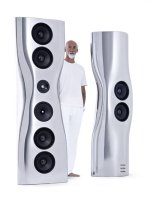She will survive with the look. But maybe she would not survive with price of four ScanSpeak WE38 drivers which you installed on your model.
😍 😎
P.S. You could drill holes in your WO24P cabinets and try them as ❤️id
😍 😎
P.S. You could drill holes in your WO24P cabinets and try them as ❤️id
Generally speaking, in the age of DSP and cheap power I prefer to put any subwoofer driver in a resonant (bass reflex or passive radiator) enclosure tuned to about 20 Hz or even lower, if driver Xmax allows, and then force response to flat from to 15-20 Hz. For a midwoofer bass ports/PRs have some drawbacks (pipe resonance, midrange leaking, etc), but for the subwoofers they are pure free gain, assuming minimal care has been taken to flare inlet and outlet and provide enough cross section.2 x SB acoustics SW26DBAC76-8 shallow subs in parallel in 30L box
Here's an ATH config file (attached ZIP) for an 18 inch woofer in an enclosure. You can modify Source.Contours to match your 15 inch woofer diaphragm in an enclosure then simulate front and rear noise cancellation in VituixCAD. Or add an ATH horn around a woofer in an enclosure. But you can only modify the enclosure by footprint so it won't simulate the rounded enclosure like you show in your design.
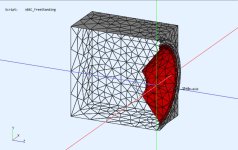

Attachments
I wonder if I am taking the same route with speaker building as other experienced people have gone, only to keep rediscovering what others have already experienced and probably even forgotten. 🤔 Only difference is that I am just playing around with fancier looking designs.
For example, I found out that all the kind of concepts that I was trying to build (cardioid 15inch woofer-mid + horn) has already been done here:
https://www.avsforum.com/threads/dsp-midrange-directivity-control-aka-kinda-cardioid.1618882/
https://www.avsforum.com/threads/forward-radiation-sickness-big-waveguide-and-cardioid.1764913/
It is interesting to see how that project ended up.
https://www.avsforum.com/threads/ds...trol-aka-kinda-cardioid.1618882/post-55021272
Exactly the kind of things that I have been thinking about in the last few of days. Sealed woofer + cardioid mid + horn.
More interesting is Nate Hansen's comment about his experience with this particular build. He says
" I would prefer a narrower pattern down to the low hundreds of hz and a cardioid is only going to get you 120 deg at best. That and the excursion demand of a gradient system down low isn't very appealing hence the sealed woofer below 200hz."
and his comments about the naturalness in sound that he could hear with the cardioid+horn concept
https://www.avsforum.com/threads/mini-synergy-horn-experiment.2245026/post-54960040
And, then he went on to build the Synergies. This was the same progression of thoughts I had in mind. First the smaller cardioid (SICA coax), then a bigger coax+horn, and then a synergy (+ ??). I wonder about what Nate would have experienced with his synergy build 🤔
Maybe I need to read this thread in detail and find out: https://www.diyaudio.com/community/threads/mini-synergy-horn-experiment.283068/
But I wonder why no one is cautioning me or discouraging me from treading down this beaten path. 🤔
I don't know what I will realize in the end.. that a simple full-range driver is the best???🤔 And then that silence is the best...
For example, I found out that all the kind of concepts that I was trying to build (cardioid 15inch woofer-mid + horn) has already been done here:
https://www.avsforum.com/threads/dsp-midrange-directivity-control-aka-kinda-cardioid.1618882/
https://www.avsforum.com/threads/forward-radiation-sickness-big-waveguide-and-cardioid.1764913/
It is interesting to see how that project ended up.
https://www.avsforum.com/threads/ds...trol-aka-kinda-cardioid.1618882/post-55021272
Exactly the kind of things that I have been thinking about in the last few of days. Sealed woofer + cardioid mid + horn.
More interesting is Nate Hansen's comment about his experience with this particular build. He says
" I would prefer a narrower pattern down to the low hundreds of hz and a cardioid is only going to get you 120 deg at best. That and the excursion demand of a gradient system down low isn't very appealing hence the sealed woofer below 200hz."
and his comments about the naturalness in sound that he could hear with the cardioid+horn concept
https://www.avsforum.com/threads/mini-synergy-horn-experiment.2245026/post-54960040
And, then he went on to build the Synergies. This was the same progression of thoughts I had in mind. First the smaller cardioid (SICA coax), then a bigger coax+horn, and then a synergy (+ ??). I wonder about what Nate would have experienced with his synergy build 🤔
Maybe I need to read this thread in detail and find out: https://www.diyaudio.com/community/threads/mini-synergy-horn-experiment.283068/
But I wonder why no one is cautioning me or discouraging me from treading down this beaten path. 🤔
I don't know what I will realize in the end.. that a simple full-range driver is the best???🤔 And then that silence is the best...
Attachments
Last edited:
What you want from your system? What you want from the hobby? It's a hobby, you can do what ever you like, what ever is most fun!🙂
If you want to explore, get experience, then build various things for learning. If you want to skip building everything, you could just think and imagine about various concepts and then arrive to something that likely provides what you want.
No matter what you do, you'd still need to listen if it worked or not, or what is more important than something else, so if you are after good sound you should develop listening skill while you are at it. I mean, simple fullrange driver speaker is about as simple as it gets and sounds pretty good, why even consider anything else? Of course, if you hear there is something that doesn't work for you, and you'd benefit having something else, then you should.
I don't know how many people do this and at what level. I have impression most members / projects, are based on trends and brands and models, gut feeling and realities, fun factor, rather than going for ultimate sound for application at hand. In fact, I'm not sure if I ever read a thread which would go through a system design that is being optimized for a particular situation. It's just bigger / more expensive stuff usually, more flashy looking, which are very fine goals as such.
Power with DIY is that you can do what ever you want, and to make most out of the freedom you can tailor fit to your specific context! Which means, you can make size and shape and looks, and performance, that is not available from box store. In other words get best possible performance and/or looks, but only because you took it further to specifics than commercial products available to you could. And to do that you must have very clear vision, or at least direction otherwise it's as random as any box store speaker. But also embrace it, the journey, if you feel like you took wrong path, then just change it, suck it up, it's all learning and you are not responsible to anyone else than yourself, and perhaps your family 😀 The sooner you identify and dump bad ideas the better.
It's a healthy thing to stop for a second and think about what one is doing, and for what reasons. Especially if there is no fun in it. Having a hobby that feels burden is waste of time and resources 🙂 So, do what ever feels fun to you!
ps. your goals might be different than anyone how beat the path before, so if someone thought a concept didn't work for him doesn't necessarily mean it wouldn't work for you. You just need to know what you are doing and what you need to be doing, and to get there just do stuff and learn until you know. Also, it could be so that the most boring and simplest system just sounds the best, so do not rule that out either, no need to go after "esoteric", just try to get to know where you are at and where you need to be heading to.
pps. if you start the thinking route, you'd likely arrive to synergies. "issue" with synergies is that it's gonna be big if you want good pattern control to low frequency. If you can accommodate big, then go for it, otherwise gradient system is what can do some directivity in a smaller form factor. It's all about compromises, and having clear goal / set of priorities help you take set of compromises you can be happy with at the end.
If you want to explore, get experience, then build various things for learning. If you want to skip building everything, you could just think and imagine about various concepts and then arrive to something that likely provides what you want.
No matter what you do, you'd still need to listen if it worked or not, or what is more important than something else, so if you are after good sound you should develop listening skill while you are at it. I mean, simple fullrange driver speaker is about as simple as it gets and sounds pretty good, why even consider anything else? Of course, if you hear there is something that doesn't work for you, and you'd benefit having something else, then you should.
I don't know how many people do this and at what level. I have impression most members / projects, are based on trends and brands and models, gut feeling and realities, fun factor, rather than going for ultimate sound for application at hand. In fact, I'm not sure if I ever read a thread which would go through a system design that is being optimized for a particular situation. It's just bigger / more expensive stuff usually, more flashy looking, which are very fine goals as such.
Power with DIY is that you can do what ever you want, and to make most out of the freedom you can tailor fit to your specific context! Which means, you can make size and shape and looks, and performance, that is not available from box store. In other words get best possible performance and/or looks, but only because you took it further to specifics than commercial products available to you could. And to do that you must have very clear vision, or at least direction otherwise it's as random as any box store speaker. But also embrace it, the journey, if you feel like you took wrong path, then just change it, suck it up, it's all learning and you are not responsible to anyone else than yourself, and perhaps your family 😀 The sooner you identify and dump bad ideas the better.
It's a healthy thing to stop for a second and think about what one is doing, and for what reasons. Especially if there is no fun in it. Having a hobby that feels burden is waste of time and resources 🙂 So, do what ever feels fun to you!
ps. your goals might be different than anyone how beat the path before, so if someone thought a concept didn't work for him doesn't necessarily mean it wouldn't work for you. You just need to know what you are doing and what you need to be doing, and to get there just do stuff and learn until you know. Also, it could be so that the most boring and simplest system just sounds the best, so do not rule that out either, no need to go after "esoteric", just try to get to know where you are at and where you need to be heading to.
pps. if you start the thinking route, you'd likely arrive to synergies. "issue" with synergies is that it's gonna be big if you want good pattern control to low frequency. If you can accommodate big, then go for it, otherwise gradient system is what can do some directivity in a smaller form factor. It's all about compromises, and having clear goal / set of priorities help you take set of compromises you can be happy with at the end.
Last edited:
From my standpoint, you are on the vanguard, the leading edge, of this kind of design. And you are sharing what you discover so we all learn.But I wonder why no one is cautioning me or discouraging me from treading down this beaten path.
This hobby is not like scientific research, where original discovery is the goal... this is more like engineering, where the goal is to create a device which serves a useful purpose. Humans have built over 500,000 bridges in the last 150 years (so I read), but that does not mean that designing and constructing the next bridge is easy or trivial... each one is different, each one requires creativity and analysis and attention to detail... if we get it wrong, people can die. Speaker design does not have the same gravitas as bridge design, but each one is different and each serves a purpose.
That's exactly what this is all about!from treading down this beaten path.
I can tell you (and you probably know) there is nothing like experiencing something between your hands, your ears and your brain.
The important bit is, you may discover something along this path that noone has ever seen before.
I find your expedition highly inspiring and insightful!
@tmuikku @hifijim @stv: Thanks a lot for giving me some perspective.. 🙂
I suddenly started thinking about what is the/if there is even an end goal to my speaker-building journey.. Afterall, this thread has become quite long..
And then I felt lost not being able to find a clear end goal..
Now that I got some time to reflect upon all this with the help of all your thoughts, I have some idea... 🙂
Initially, I had ideas like making a speaker that beats what can be purchased from stores both in terms of value and quality.
Then, for some time, I was chasing accuracy in sound reproduction. I think that didn't go anywhere.
These days I think it is all a more personal pursuit about finding what flavour of sound one likes. And it is very subjective.
To approach the subjective, I feel that the objective design route gives guidelines, maybe a way forward out of difficult situations, where subjective alone doesn't help.
I think I am in this hobby to do something creative and to really learn something new every day, all the while enjoying the process.
Music is something I love; makes me happy, and these speakers that I make bring music alive... 🙂
Probably, there is no end goal. This journey itself is the goal, at least for me.. 🙂
I suddenly started thinking about what is the/if there is even an end goal to my speaker-building journey.. Afterall, this thread has become quite long..
And then I felt lost not being able to find a clear end goal..
Now that I got some time to reflect upon all this with the help of all your thoughts, I have some idea... 🙂
Initially, I had ideas like making a speaker that beats what can be purchased from stores both in terms of value and quality.
Then, for some time, I was chasing accuracy in sound reproduction. I think that didn't go anywhere.
These days I think it is all a more personal pursuit about finding what flavour of sound one likes. And it is very subjective.
To approach the subjective, I feel that the objective design route gives guidelines, maybe a way forward out of difficult situations, where subjective alone doesn't help.
I think I am in this hobby to do something creative and to really learn something new every day, all the while enjoying the process.
Music is something I love; makes me happy, and these speakers that I make bring music alive... 🙂
Probably, there is no end goal. This journey itself is the goal, at least for me.. 🙂
For people like us, the journey is the goal. The end result is a goal too, but the journey is the major point.This journey itself is the goal, at least for me.. 🙂
There are people on this forum who are audio / music professionals. There are people who design speakers, audio equipment, and recording studios. For these people, the goal is quite different. They have to provide a product or service to a paying customer. They must provide something which the customer values more highly than the money that comes out of their wallet. They are compared to their competitors, and they must compete against them. At the end of the day, they have to make enough money at this activity to justify doing this instead of some other job.
For people like us, we do this for fun and enjoyment. We have no schedule but our own, and no budget but our own. We define our own design goals, our own specifications, our own mission. We get satisfaction from both the end result, and the journey to get to that result.
I highly value the contributions of the professionals on this forum. I always keep in mind, however, that they have a different perspective and a different motivation than I do. Just as they must consider my advice and comments, and keep in mind that the way I do things has little consideration with efficient use of time or resources, and thus my methods might be inappropriate to a profit making operation.
Keep going, Vineeth. !
pps. if you start the thinking route, you'd likely arrive to synergies. "issue" with synergies is that it's gonna be big if you want good pattern control to low frequency. If you can accommodate big, then go for it, otherwise gradient system is what can do some directivity in a smaller form factor. It's all about compromises, and having clear goal / set of priorities help you take set of compromises you can be happy with at the end.
KEF Blade doesn't extend directivity index as high or as low in frequency and doesn't have the dynamics of a synergy but they also don't have the deep waveguide. I wonder if Kimmosto would prefer the KEF over the synergy in a home environment. Has anyone tried to DIY a Blade yet?
Vineeth has coaxial experience and rigid foam skills under his belt. I was really impressed by the visual draw of his coaxial enclosures. He has the ability to successfully shape an enclosure as complex as a Blade and refine his ABEC simulation skills in the process. My suspicion is there is more home Hi-Fi sonic value in KEF's strategy than copying a synergy build. Kimmosto mentioned he uses KEFs (in addition to JBLs and some small full range Scan-Speaks) in his own home. So I'll come out as one vote in favor of urging Vineeth away from continuing down his path toward synergies 😛.
After that project Vineeth would only be one step away from being capable of designing a Blade / Kii Three mash-up. Also, Vineeth has 3D printing skills. Patrick Bateman worked on the KEF Meta rear chamber silencers and ATH software is able to shape that black portion around the KEF coaxial that connects it to the enclosure. The more I think about it Synergies seem like kind of a waste of his knowledge, skills, and abilities. Synergies don't even seem like the type of creativity Vineeth chases. The exception to everything I've said is if Synergies create the kind of sound he prefers.
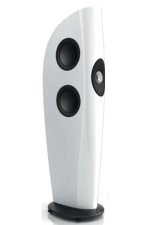
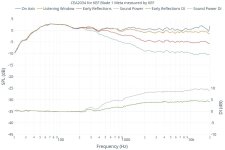
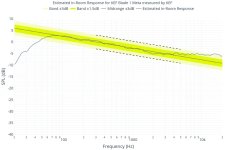
https://www.spinorama.org/speakers/KEF Blade 1 Meta/KEF/index_vendor-v2-20230503.html
Last edited:
You can see a simulation of a blade style speaker hereHas anyone tried to DIY a Blade yet?
https://www.diyaudio.com/community/threads/tachi-coaxial-point-source-bem-modelling.386711/
Simulation is as far as that one will get from me, I think there are better ways to use the drivers.
^^^
Agreed.
but what would you do @fluid ?
I think I’d sooner take the take the Reference and put 1.5” round overs on them, over the Blade. 😱
@vineethkumar01
There is a lot we don’t know, because there is a paucity of evidence. The CTA2034A, published in 2015, is nice. But it still leaves distortion, directivity and dynamic range on the table for further interpretation.
But what is the preferred directivity, dynamic range or distortion? Surely that depends on the use case, and the environment in which it is used?
So IMHO It’s definitely about the learning, the creation, the journey. The sharing.
There is no destination. Perfection is an illusion that keeps us going.
And besides, be aware that it could be just the brain.
The brain likes novelty. This is evidence based.
Agreed.
but what would you do @fluid ?
I think I’d sooner take the take the Reference and put 1.5” round overs on them, over the Blade. 😱
@vineethkumar01
There is a lot we don’t know, because there is a paucity of evidence. The CTA2034A, published in 2015, is nice. But it still leaves distortion, directivity and dynamic range on the table for further interpretation.
But what is the preferred directivity, dynamic range or distortion? Surely that depends on the use case, and the environment in which it is used?
So IMHO It’s definitely about the learning, the creation, the journey. The sharing.
There is no destination. Perfection is an illusion that keeps us going.
And besides, be aware that it could be just the brain.
The brain likes novelty. This is evidence based.
Last edited:
Something more in the vain of a Kii3 but with a coax MT, or passive cardioid coax similar to how Vineeth used it with the other drivers in some form of frontal array or active cardioid for volume limited applications.but what would you do @fluid ?
Maybe that is why a diy version of a KEF muon kind of speaker with a bit less art and more acoustically sensible design choices makes sense.. 🙂I think I’d sooner take the take the Reference and put 1.5” round overs on them, over the Blade. 😱
Thanks a lot 🙂So IMHO It’s definitely about the learning, the creation, the journey. The sharing.
There is no destination. Perfection is an illusion that keeps us going.
And besides, be aware that it could be just the brain.
The brain likes novelty. This is evidence based.
Edit: The muon looked assymetric to my eyes till now. But when I looked at other photos, it looks symmetrical. That was one of my gripes earlier. Anyway KEF knows better than me about making speakers 😀
Attachments
You need a big 3D printer.
Or like Perry’s live edge dipoles, go find a big tree trunk, hollow it out and build your own.

Doesn’t look too bad in high gloss piano black.
Or like Perry’s live edge dipoles, go find a big tree trunk, hollow it out and build your own.
Doesn’t look too bad in high gloss piano black.
@CinnamonRolls: Thanks a lot for your support.. An MEH kind of project has always been on my mind. It has been a curiousity for a while.. 😀
And recently with this MEH-cardioid project here, that curiousity just went through the roof.. 😀
https://www.diyaudio.com/community/...-design-the-practical-way.354772/post-7455192

The thing that I like about a horn system is the dynamics. The moment I start playing something on the horn system, it feels like music just comes alive. A bit more balance to that kind of sound and a bit more smooth and impactful bass is all I am chasing for now.. The recent cardioid mid project has most of what I am looking for overall sound balance wise and suits the nearfield application, but it lacks the dynamics that I am used to, when I listen to them from a bit far away. And I miss some bass.. So the next atrempt is to focus on what can be done about it.. 🙂
Anyway, before jumping into such a project, I will wait, take a breath, try to learn more, iterate over more designs and play around with something that fits better in my home, like you and others have been pointing out.. 🙂
And recently with this MEH-cardioid project here, that curiousity just went through the roof.. 😀
https://www.diyaudio.com/community/...-design-the-practical-way.354772/post-7455192
The thing that I like about a horn system is the dynamics. The moment I start playing something on the horn system, it feels like music just comes alive. A bit more balance to that kind of sound and a bit more smooth and impactful bass is all I am chasing for now.. The recent cardioid mid project has most of what I am looking for overall sound balance wise and suits the nearfield application, but it lacks the dynamics that I am used to, when I listen to them from a bit far away. And I miss some bass.. So the next atrempt is to focus on what can be done about it.. 🙂
Anyway, before jumping into such a project, I will wait, take a breath, try to learn more, iterate over more designs and play around with something that fits better in my home, like you and others have been pointing out.. 🙂
Is it the horn dynamics- Or is it the decision of the horn to encourage designers to avoid 85dB/2.83V mid bass. And choose higher sensitivity mid bass drivers.
Or is it due the the horn’s directivity- with less output at wide off axis angle and first reflections from the side walls. Certainly I wonder what the ideal horizontal beam width is- 50, 60, 70, 80? And over what frequencies?
And what about vertical?
I wonder if it’s the latter (directivity)
My main system is -92dB/2.83V (if it was passive) and goes from (only) 40Hz to 20Hz. Twin 12” woofer in sealed box. The max SPL is limited due to the dome tweeter without waveguide- and that is 112dB.
This plays much more lifelike than another system with 82dB/2.83V which can only play at less than 100dB (single 8” woofer in sealed box, similar F3/F6/F10) but has a more consistent 60 degree beamwidth
Or is it due the the horn’s directivity- with less output at wide off axis angle and first reflections from the side walls. Certainly I wonder what the ideal horizontal beam width is- 50, 60, 70, 80? And over what frequencies?
And what about vertical?
I wonder if it’s the latter (directivity)
My main system is -92dB/2.83V (if it was passive) and goes from (only) 40Hz to 20Hz. Twin 12” woofer in sealed box. The max SPL is limited due to the dome tweeter without waveguide- and that is 112dB.
This plays much more lifelike than another system with 82dB/2.83V which can only play at less than 100dB (single 8” woofer in sealed box, similar F3/F6/F10) but has a more consistent 60 degree beamwidth
Last edited:
Go to love horns.they sound real .one could assume then that horn speakers are real speakers.and listening to real speakers we must be real men.
Ironically, I liked the presentation of sound by my horn system in my earlier echo chamber room better than my current room which is much more damped due to furniture, less space overall and its assymetry. Now it sounds a little less spacious overall but has nice imaging and sound restricted mostly to between the speakers.. Well earlier, I had nice imaging + spaciousness and dynamics. The only thing bothering me there was the bass and a tiny bit of the system calling attention to mids + highs..
So I think I like a bit of wide directivity, 45+ degrees one sided beamwidth, the top end/HF extension of a 1inch CD on a suitable horn and midbass drivers with highish sensitivity and some pattern control in the region
Speaker design language-wise, I will prefer something like this in the living room compared to a KEF muon monolith. My wife might like it better too 😀

Well, we change the color, make the woofer large and cardioid, lose the topmost small horn and have a downfiring subwoofer integrated with above system.. Makes it also easier to move to a Synergized horn, if needed later.
Let me try if something can be done along these lines.. 😀
So I think I like a bit of wide directivity, 45+ degrees one sided beamwidth, the top end/HF extension of a 1inch CD on a suitable horn and midbass drivers with highish sensitivity and some pattern control in the region
Speaker design language-wise, I will prefer something like this in the living room compared to a KEF muon monolith. My wife might like it better too 😀
Well, we change the color, make the woofer large and cardioid, lose the topmost small horn and have a downfiring subwoofer integrated with above system.. Makes it also easier to move to a Synergized horn, if needed later.
Let me try if something can be done along these lines.. 😀
Last edited:
- Home
- Loudspeakers
- Multi-Way
- A 3 way design study
